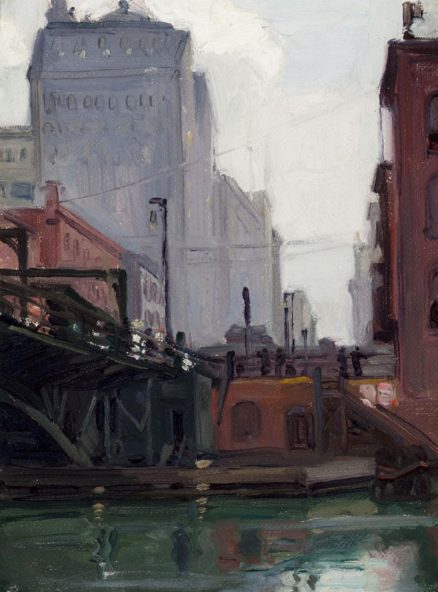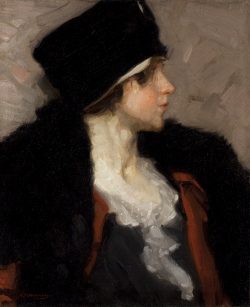- Categories
- Chicago places & people
- Landscapes
- Zoom in on Artwork
- Print Page
- Email Page to Friend
In his painting of a bridge, riverside warehouses, and urban buildings, E. Martin Hennings focused on the types of structures that defined Chicago as a modern commercial metropolis in the early twentieth century. The view is from the water’s surface, as if from a boat, with the underbed of the bridge a dark mass on the left. The unseen street is marked by the vista of receding buildings, many of red brick, yielding to invisibility in the smoky atmosphere for which the city was once notorious. Hennings’s setting is easily identified as the south bank of the Chicago River’s central branch where State Street crossed the water via a drawbridge (since replaced). The tallest building, on the left, is the twenty-one-story Masonic Temple building, with the double gables of its roof punctuated on the north side by seven dormer windows. The painting’s low viewpoint and vertical format accentuate the height of this edifice, one of Chicago’s most famous and the world’s tallest building when it was completed in 1892. (It was demolished in 1939.)
In the 1910s, the Masonic Temple marked the boundary between the industrial district along the riverbank and, south of Randolph Street, the famed State Street shopping district, with its elegant department stores. Although Chicagoans prided themselves on the sophistication and civility of the retail hub, artists were attracted to the industrial river, with its metal moveable bridges and looming warehouses. As demonstrated here, fluid brushwork, an unconventional perspective, and subtle color contrasts could transform these unlikely features into elements of decorative compositions that at the same time celebrated Chicago’s distinctive character.
Executed in sure but rapidly applied strokes of paint, this work is a study, probably made onsite, for a larger, more finished painting exhibited as The Bridge (location unknown) in the Art Institute’s “Chicago and Vicinity” annual exhibition of 1917. A local critic pronounced it “possessed of sterling worth.”i At that early point in his career as an easel painter, Hennings made primarily figural works and portraits; The Bridge was a rare artistic foray into the urban landscape. In choosing this particular view he was likely influenced by a painting acquired by the Art Institute only two years earlier, in 1915: Alson Skinner Clark’s The Coffee House (1905–1906; Art Institute of Chicago), a study for which is in the Schwartz Collection. While the elevated viewpoint of Clark’s composition draws the viewer vicariously into the flow of traffic southbound on State Street, Hennings instead confines the scene to the perspective of a deckhand, an observer for whom the heart of the city was its industrial river rather than its streets.
Wendy Greenhouse, PhD
Donated by M. Christine Schwartz to the Newberry Library, Chicago, Illinois, in 2021
i Louise James Bargelt, “Prizes Awarded in Exhibitions of Chicago Artists,” Chicago Tribune, Feb. 4, 1917.

